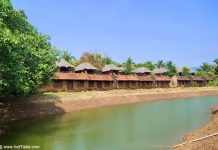Agroha is the place where I would trace my origins to. This is the place where our ancestors Maharaja Agrasen ruled. However, it took me discovering many historical places in India before I reached Agroha on a cold January evening.
Brief History of Agroha
Maharaja Agrasen was a Kshatriya of Suryavamsha or the solar dynasty. He was the 36th descendant of Sri Ram of Ayodhya through his son Kush. It is also said that he set up his capital in Agroha after the Mahabharat War. His father fought in the Mahabharat War as per the chronicles at Agroha.
Ther or Ancient Mound at Agroha
Agroha falls on the ancient trade route connecting Takshashila and Mathura. No wonder then that the most popular and successful trading community has its roots here.

Spread across 566 acres, this ancient mound that has many brick structures including a fort-like formation has remnants from 3-4th BCE and till about 13-14th CE. That is a long period of history. Potteries from the Kushan and Gupta periods were found here during excavations.
A Buddhist Stupa belonging to the late Kushan or early Gupta period can be seen here. As I walked up and down on the exposed red bricks of this stupa, it reminded me of Nalanda which has very similar though much larger structures.
Adjacent to it is a Hindu Temple. Both these structures are surrounded by narrow cells that may have been meditation cells or dormitories of a monastery.
Agroha Dham
Agroha Dham is spread across a sprawling 67-acre campus built between 1976-84 CE.
The main attraction is the Trikuta temple with three towering Shikharas. On the top of the temple, a large Murti of Sun riding his horses greets you. This depicts the lineage from the Sun or Suryavamsh.
The central temple belongs to Mahalaskhmi who is the Kuldevi of the Agarwal community.
Mahalakshmi
The story goes that Maharaja Agrasen had worshipped Mahalakshmi and she appeared before him. Since then, she has become the presiding goddess of the clan.
The vigraha of Mahalakshmi here is with four arms and is in a standing position. Her two hands are holding the lotus and the other two are in Abhay and Varada mudras which stand for fearlessness and blessings.
Inside the garbhagriha, you can see glass paintings of Ram Darbar and Radha Krishna on either side of Mahalakshmi. On the side wall, you see a painting of Maharaja Agrasen praying to Mahalakshmi as she gave him darshan.

The left temple is dedicated to Maharaja Agrasen as the Mool Purush of the Agarwal clan. His Murti as a king is shown sitting on a throne. He is surrounded by his 18 sons who are now the 18 gotras of the Agrawal community. There is a Ram Darbar here. It was beautifully decorated as we were there on the day Pran Pratishtha of Ram Mandir in Ayodhya was going on.
The temple on the right has Saraswati Devi in a sitting posture wearing white and playing Veena. Next to it is a Murti of Kalki Bhagwan – the future incarnation of Vishnu riding a horse.
Hanuman Murti
Other temples on the campus include a 90-foot-tall Hanuman Murti towering over a small but very beautiful Hanuman temple beneath. There are temples of Devi as Durga and Krishna as Dwarkadhish. A temple behind the main temple has replicas of all the 12 jyotirlingas. Mahakal is the biggest of them. There are diorama-based electronic jhankis or scenes from Ram Katha and Krishna Katha.
The most fascinating part of the temple is a recreation of Amarnath and Vaishno Devi Yatra with caves on the top floor of the temple. It takes you some time to go through narrow cave-like structures, sometimes through a tiger’s mouth, to reach the deities in the cave and then come out. In between you meet the exact replica of Tirupati Balaji. Many people tie coconuts here after worshipping Vaishno Devi and Bhairava for the fulfillment of wishes.
There is a Sarovar or pond that has sacred water from 41 sacred rivers across India. You can do boating and there are a few activities to keep children and everyone else too engaged.
Festivals
The biggest festival here is celebrated in Sharad Ritu and in the month of Ashwin. On the first day of Ashwin month is Jayanti of Maharaja Agrasen. The Purnima of this month called Sharad Purnima, is the celebration of the annual festival of Mahalakshmi.
We attended the morning Arti around 7:30 PM and it was a divine experience. I recommend you attend at least one Arti when you visit.
You need a day to comfortably enjoy Agroha Dham.
Lakshmi Shakti Peeth
All India Agrawal Sabha has another campus with a temple dedicated to Maharaja Agrasen. A grand Lakshmi temple is being built. There is a yagnashala with 18 yagna kundas representing the 18 Agrawal Gotras.
A beautiful Sarovar here has a lovely Murti of Ganga standing on her vehicle Makar or crocodile. A board here tells us that sacred water from 18 rivers has been brought here, sanctified by Vedic chants and these tirthas stay here forever. It means that this Agra Sarovar has all the Tirthas living here. Visiting it is worth visiting all the Tirthas of Bharat.

A gallery here shows the events from the life of Maharaja Agrasen. It covers his journey from the time of his praying to Mahalakshmi to the Government of India issuing a postal stamp on him in 1976, and to National Highway No 9 being named after him.
A huge hall showcases the achievers from the community with their photographs. There are busts of leaders from the society like Lala Lajpat Rai, Bhartendu Harishchandra, and a plethora of philanthropists and businessmen. It is still a work in progress like a business is.

In the temple of Maharaja Agrasen, you can see Agra Bhagwat – a Puranic tale of Agrawals. I picked up a copy and hope to read it soon. The concept of ‘Ek Int, Ek Rupiya’ – a philosophy of helping every new family to set up their business and hence life is on display.
A bookstore offers literature on Maharaja Agrasen and Agrawals. I wish they would add to it the literature authored by and written about Agrawals here. This would help the community appreciate the work of the larger community.
Sheela Mata Mandir
A temple dedicated to Sheela Mata is located about 500 meters from Agroha Mound and maybe a kilometer from Agroha Dham. Surrounded by bright yellow mustard fields, this temple in Pink stone was celebrating the Ram Mandir Pran Pratishtha with a Yagna. We participated by chanting Hanuman Chalisa and exchanging greetings.
All the temples in and around Agroha are well-maintained.
Kajala Dham Hanuman Mandir
A little before Hisar on the Delhi-Hisar Road, there is a very popular Hanuman temple called Kajala Dham. We stopped here on our way to Agroha and participated in the evening Arti.
Though not an old temple, it has a huge following as a wish-fulfilling Hanuman Mandir. People tie coconuts on its walls and they say their wishes come true.
The old temple is towards the right as you enter. You approach the big temple through a flight of steps. It has a beautiful five-faced Panch-Mukhi Hanuman Murti in the center surrounded by all other Hindu deities. There is glasswork that I have more often seen in Jain temples.
Travel Tips
- Almost all temples are open from morning to evening
- You can do photography outside the main temple, but not inside
- Dharamshalas are available within the temple premises and hotels are available in close vicinity. Free food is available at Dharamshala at stipulated times. However, you can pay what you want at the time of checkout
- You can visit Rakhigarhi – the largest Sindhu Saraswati Civilization site discovered so far.


















Good Article 👍